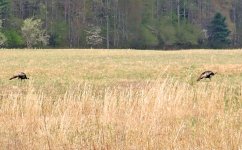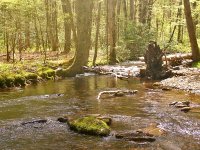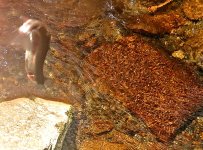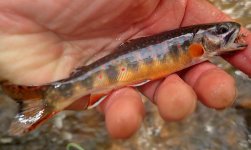Here in the Smokies, winter grinds you down to a nub by the time it's over. That's not so much because of its severity compared to the northern tier of states, but simply because of its stubborn refusal to go away. It's mid-April, and most of the southeast is well into springtime, with people already picking produce from their gardens. Here, it will be a couple weeks into May before you can even start planting with reasonable certainty that frost won't kill your work. It's a strange time of year. Trees are starting to sprout leaves, wildflowers are blooming, turkeys are gobbling, and some afternoons top out in the upper 70s. But, the next day, the highs may be in the 40s with a heavy frost appearing on the ground overnight, or even a skiff of snow. All the signs of spring are here, but my mind hasn't reset from winter to spring yet, because I still haven't performed the ritual that changes the seasons in my head. I have caught trout already this year, sure. But that has been more of a matter of drudgery than art, dredging them out of their deep, hidden winter lies with heavily weighted nymphs and split shot. I still haven't caught a native trout on a dry fly this year. That is my one absolute annual ritual that kicks the reset button in my brain, and makes it become springtime. It is time.
I have taken the day off work, and the forecast calls for mid-to-upper 70s this afternoon. Even so, the thermometer hovers just under 40 this morning, so I am in no big hurry to get to the creek. Partly because the rule set of The Reset Ritual also requires the lack of waders. It isn't spring to me until trout rise to a fly, and I can wade wet without succumbing to hypothermia. After all, the whole point of this thing is to welcome back the warm and living part of the year after nearly six months of monotonous cold, gray, frozen death.
The ritual usually occurs on the same creek most years- the watershed that I would describe as my home water. The waters that taught me to fly fish in my earlier years. I know every pool, run, and riffle over miles of creeks here from years of fishing them. And it's all native and wild fish that have been here long enough to become almost native, with no pitiful, pale stocker trout to interfere with my annual communion with the water. Every fish in this water belongs here. And that's important, because today I am not out to catch fish. I am out to catch a particular fish in a particular way. That's the way it has to work for the ritual itself to work.
It is about 10:30 before I pull up beside the creek and get out of the truck and start rigging a three-weight with twelve feet of dry-fly leader tapering down to 5x the last few feet. I look in my fly boxes for a fly to tie on the end, and realize that I have been slack in my fly-tying lately. The selection is sparse, but this time of year, if the trout are rising, they will rise to about any decent fly that you put in the right place and present reasonably perfectly. I do prefer to use old, traditional mountain patterns for this annual rite, because it just feels right, and some modern, synthetic guide pattern just wouldn't. I select my last remaining Charley Whopper, tie it to the end of the tippet, and grease it up. This is a big, bushy gray fly tied on a #10 hook, vaguely resembling the offspring of a drunken night between an Adams, Thunderhead, and Groundhog Caddis. It demands attention on the water. The pattern was invented long ago a few miles from here by a distant cousin of mine and local old-timer fly fishing guru, Charles Messer. One of the old guys who first taught me how to tie flies back in the day. This was one of his favorite creeks to fish, too, so he would be proud to see somebody still following his legacy, I'm sure.
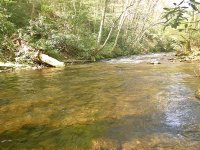
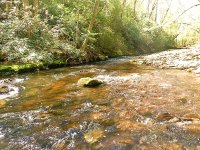
I have decided to start on the upper reaches of the main stem of the creek for a couple hours. It is still decent-sized water here, but small enough to be easily wadable, and open enough to work some line out in most places. The sun is out overhead now behind a haze of rapidly burning fog, and the temperature has climbed up to about 60. The water is still cold enough that I have a sharp intake of breath on my first step into the creek when the water fills my boots. My first few casts are awkward after months without holding a dry fly rod. I soon miss a couple of fish, and as I work to unsnag my fly from the resulting tree limb, bush, or blowdown tree that a missed strike inevitably lands it in, I marvel at the amazing ability of a trout fly to firmly and fastly embed itself in any object on earth except a trout's lip.
Then, it happens. The fly floats down a current seam beside a boulder, and suddenly disappears from the surface with a small splash and flash of red fins. I set the hook, and feel life on the other end of my leader-a primal and living connection like an electric shock. Soon, a small native Southern Appalachian brook trout is in my hand. I see this as an excellent omen, because this is exactly the fish I came here hoping to find, and for it to be the first to eat my fly today makes me happy. I admire its depth of colors, and wonder and marvel at who or what originally painted them into its DNA. They did good, achieving close to artistic perfection. I lower my hand to the water, and the fish is gone in a fraction of a second, disappearing as though it never was. But now, everything suddenly feels different, and my whole attitude has changed. In less than a minute, it is Spring, and my mind has shifted gears. I look out at the surface of the riffle that somehow looks different and more alive now, and offer a sincere thanks to that little fish for being part of my ritual, and releasing my mind from the grind of winter. I may wake up to an inch of snow in a few days, but thanks to that little fish, it is now officially Springtime.
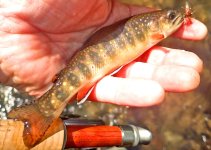
As I fish upstream, fish rise regularly to my fly. Most significant is that the vast majority of them are native specks, with only an occasional rainbow or brown. This is a big change, and one that makes me happy. When I first cast a fly into these waters over forty years ago, catching a speck in this stretch of the main creek would have been an anomaly, and would likely only have happened after a flood washed it down from the headwaters. The water I am casting to now was almost solely rainbow and brown water then, but the natives have been slowly but surely moving back downstream over the last decades as the forests have regrown and matured, reclaiming territory from the browns and rainbows. I hope that I live long enough to see this trend come to fruition. When I was young, I heard my grandpa and great-unles and other old timers talk of commonly catching native brook trout that measured in the teens, before the industrial logging and stocking of rainbows drove them out of the bigger streams and back up into the headwaters to become the beautiful but minuscule fish that I know and love. One can hope. And hope comes easy on a beautiful, warm spring day when the fish are rising to dry flies.
A little further upstream, I hit a stretch where I don't get a single rise for about a hundred yards or more. Maybe somebody else has fished it this morning, putting the trout down, or maybe an otter has been through, chasing down his breakfast. At the upper end of this stretch, I cast my fly into a particularly inviting deep, dark run that undercuts the rootmass of a streamside sycamore. After the previous long stretch with no hits, when a fat, solid brown in the teens suddenly shoots from under the roots and grabs my fly, I am startled, and make a reactive hookset that Bill Dance would have been proud of. The tippet parts in an instant, and the trout jumps clean of the water in a cartwheel of crimson spots and yellow belly, fly still attached- even though he is no longer attached to me. In an instinctive effort to rid himself of the thing that is still stinging his lip, he is still putting up a fight and a show for me.
I retie, this time with a Yellow Palmer, another old traditional pattern that originated long ago here in this same county. One of those patterns that just always seems to work. It looks exactly like no particular bug, but at the same time is suggestive of almost any bug. I fish on up to the confuence where the two main forks of the creek come together to form the main stem, picking up a few more trout along the way. It is now midday, and my growling stomach reminds me that I didn't eat breakfast this morning. I hook my fly on the hook keeper, and walk back to my truck through dappled shade and swarms of butterflies.

I have taken the day off work, and the forecast calls for mid-to-upper 70s this afternoon. Even so, the thermometer hovers just under 40 this morning, so I am in no big hurry to get to the creek. Partly because the rule set of The Reset Ritual also requires the lack of waders. It isn't spring to me until trout rise to a fly, and I can wade wet without succumbing to hypothermia. After all, the whole point of this thing is to welcome back the warm and living part of the year after nearly six months of monotonous cold, gray, frozen death.
The ritual usually occurs on the same creek most years- the watershed that I would describe as my home water. The waters that taught me to fly fish in my earlier years. I know every pool, run, and riffle over miles of creeks here from years of fishing them. And it's all native and wild fish that have been here long enough to become almost native, with no pitiful, pale stocker trout to interfere with my annual communion with the water. Every fish in this water belongs here. And that's important, because today I am not out to catch fish. I am out to catch a particular fish in a particular way. That's the way it has to work for the ritual itself to work.
It is about 10:30 before I pull up beside the creek and get out of the truck and start rigging a three-weight with twelve feet of dry-fly leader tapering down to 5x the last few feet. I look in my fly boxes for a fly to tie on the end, and realize that I have been slack in my fly-tying lately. The selection is sparse, but this time of year, if the trout are rising, they will rise to about any decent fly that you put in the right place and present reasonably perfectly. I do prefer to use old, traditional mountain patterns for this annual rite, because it just feels right, and some modern, synthetic guide pattern just wouldn't. I select my last remaining Charley Whopper, tie it to the end of the tippet, and grease it up. This is a big, bushy gray fly tied on a #10 hook, vaguely resembling the offspring of a drunken night between an Adams, Thunderhead, and Groundhog Caddis. It demands attention on the water. The pattern was invented long ago a few miles from here by a distant cousin of mine and local old-timer fly fishing guru, Charles Messer. One of the old guys who first taught me how to tie flies back in the day. This was one of his favorite creeks to fish, too, so he would be proud to see somebody still following his legacy, I'm sure.


I have decided to start on the upper reaches of the main stem of the creek for a couple hours. It is still decent-sized water here, but small enough to be easily wadable, and open enough to work some line out in most places. The sun is out overhead now behind a haze of rapidly burning fog, and the temperature has climbed up to about 60. The water is still cold enough that I have a sharp intake of breath on my first step into the creek when the water fills my boots. My first few casts are awkward after months without holding a dry fly rod. I soon miss a couple of fish, and as I work to unsnag my fly from the resulting tree limb, bush, or blowdown tree that a missed strike inevitably lands it in, I marvel at the amazing ability of a trout fly to firmly and fastly embed itself in any object on earth except a trout's lip.
Then, it happens. The fly floats down a current seam beside a boulder, and suddenly disappears from the surface with a small splash and flash of red fins. I set the hook, and feel life on the other end of my leader-a primal and living connection like an electric shock. Soon, a small native Southern Appalachian brook trout is in my hand. I see this as an excellent omen, because this is exactly the fish I came here hoping to find, and for it to be the first to eat my fly today makes me happy. I admire its depth of colors, and wonder and marvel at who or what originally painted them into its DNA. They did good, achieving close to artistic perfection. I lower my hand to the water, and the fish is gone in a fraction of a second, disappearing as though it never was. But now, everything suddenly feels different, and my whole attitude has changed. In less than a minute, it is Spring, and my mind has shifted gears. I look out at the surface of the riffle that somehow looks different and more alive now, and offer a sincere thanks to that little fish for being part of my ritual, and releasing my mind from the grind of winter. I may wake up to an inch of snow in a few days, but thanks to that little fish, it is now officially Springtime.

As I fish upstream, fish rise regularly to my fly. Most significant is that the vast majority of them are native specks, with only an occasional rainbow or brown. This is a big change, and one that makes me happy. When I first cast a fly into these waters over forty years ago, catching a speck in this stretch of the main creek would have been an anomaly, and would likely only have happened after a flood washed it down from the headwaters. The water I am casting to now was almost solely rainbow and brown water then, but the natives have been slowly but surely moving back downstream over the last decades as the forests have regrown and matured, reclaiming territory from the browns and rainbows. I hope that I live long enough to see this trend come to fruition. When I was young, I heard my grandpa and great-unles and other old timers talk of commonly catching native brook trout that measured in the teens, before the industrial logging and stocking of rainbows drove them out of the bigger streams and back up into the headwaters to become the beautiful but minuscule fish that I know and love. One can hope. And hope comes easy on a beautiful, warm spring day when the fish are rising to dry flies.
A little further upstream, I hit a stretch where I don't get a single rise for about a hundred yards or more. Maybe somebody else has fished it this morning, putting the trout down, or maybe an otter has been through, chasing down his breakfast. At the upper end of this stretch, I cast my fly into a particularly inviting deep, dark run that undercuts the rootmass of a streamside sycamore. After the previous long stretch with no hits, when a fat, solid brown in the teens suddenly shoots from under the roots and grabs my fly, I am startled, and make a reactive hookset that Bill Dance would have been proud of. The tippet parts in an instant, and the trout jumps clean of the water in a cartwheel of crimson spots and yellow belly, fly still attached- even though he is no longer attached to me. In an instinctive effort to rid himself of the thing that is still stinging his lip, he is still putting up a fight and a show for me.
I retie, this time with a Yellow Palmer, another old traditional pattern that originated long ago here in this same county. One of those patterns that just always seems to work. It looks exactly like no particular bug, but at the same time is suggestive of almost any bug. I fish on up to the confuence where the two main forks of the creek come together to form the main stem, picking up a few more trout along the way. It is now midday, and my growling stomach reminds me that I didn't eat breakfast this morning. I hook my fly on the hook keeper, and walk back to my truck through dappled shade and swarms of butterflies.

To be continued.....


